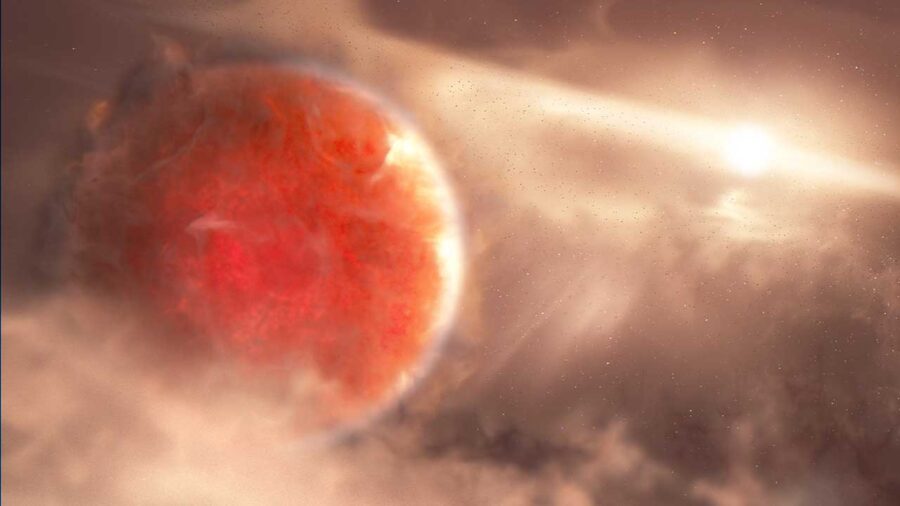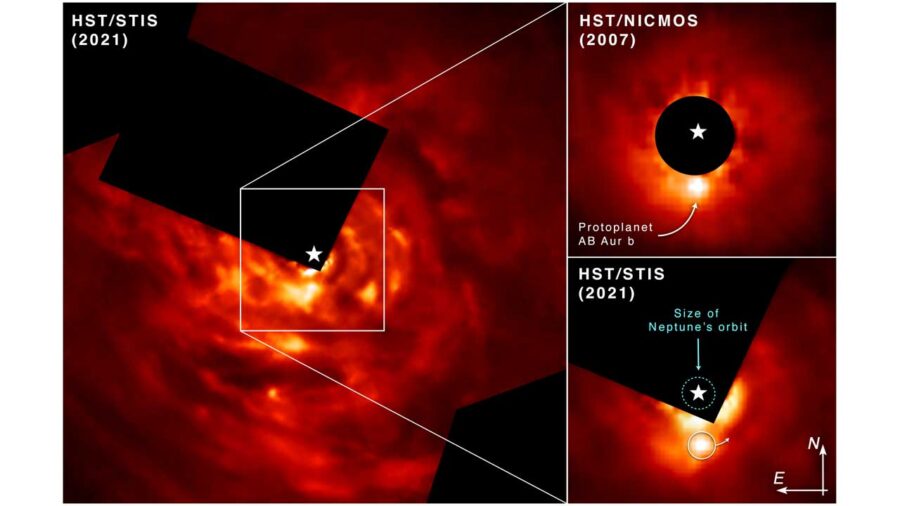At the extremes: A hot Jupiter reveals extreme chemistry on a sizzling world, and a cold Jupiter sheds light on giant planet formation.
Two Jupiter-size planets have made headlines this week, but despite their similar sizes, they couldn’t be more different. One of these is WASP-178b, a hot Jupiter that whizzes around its star every three days. It’s not only its proximity that makes this world sizzle; the star it circles is also one of the hottest exoplanet hosts known.
The other Jovian world is AB Aurigae b, a just-discovered planet-to-be some 10 times Jupiter’s mass that swings around its star in a slow, chilly loop some 100 astronomical units out, at more than twice the width of Pluto’s orbit.
These giants are providing new insights into the formation and chemistry of extreme worlds.
AB Aurigae b: Giant in the Making

NASA / ESA / Joseph Olmsted (STScI)
Let’s start at the beginning with AB Aurigae b, a world that’s just starting to come together in the outskirts of a planet-forming disk around a young star only 2 million years old.
Thayne Currie (National Astronomical Observatory of Japan) and colleagues discovered AB Aur b in images taken between 2016 and 2020 with the Subaru Coronagraphic Extreme Adaptive Optics (SCEX-AO) system on the Subaru Telescope. The team obtained additional images with the Hubble Space Telescope in 2021, and they dug up Hubble images from 1999 and 2007, too. All told, the images span nearly 22 years, and they trace a giant clump’s motion around the young star.

NASA / ESA / Thayne Currie (Subaru Telescope, Eureka Scientific Inc.)
Unlike most distant worlds amenable to direct imaging, this planet is still in the early throes of formation and the images do not capture light from the planet itself. The clump in the protoplanetary disk is seven a.u. wide and it’s sizzling at 2200K (3500ºF). What the image captures is instead the hot gas that’s flowing in to make a gas giant.
Astronomers think most gas giants, particularly those forming closer to their parent star, come together via core accretion. First, planetesimals glom onto each other to make a terrestrial clump, then that core gathers gas around it in a thick envelope. But in a protoplanetary disk’s outskirts, there’s not enough gas for core accretion to work.
Based on the clump’s location near spiral arms within the disk, Currie’s team makes the case in Nature Astronomy that this world is forming via disk instability, in which a part of the protoplanetary disk collapses in violent fashion.
“This new discovery is strong evidence that some gas giant planets can form by the disk instability mechanism,” agrees Alan Boss (Carnegie Institution of Science), who was not involved in the study.
WASP-178b: Hot Jupiter with Rocky Vapors

NASA / ESA / Leah Hustak (STScI)
WASP-178b is only a little more massive than Jupiter, but with a tight orbit around a hot star, its atmosphere is utterly alien.
In hot Jupiters, metals can vaporize and even rain out. In the uppermost layers, raindrops might be water or ammonia, but deeper in the planet’s atmosphere, droplets might consist instead of salts, iron, silicates (i.e., rocks), or even refractory ceramics. On even hotter Jupiters, those more “normal” upper layers are lost, and the more exotic rains fall higher up in the atmosphere.
WASP-178b is one of the hottest Jupiters there is, and in the April 7th Nature, Joshua Lothringer (Utah Valley University) and David Sing (Johns Hopkins University) report the detection of silicon monoxide gas in its atmosphere. This gas, if present, represents the gaseous precursor to rocky rain.
Analysis of the Hubble observations suggests that whatever rocks there are remain in gas form on the day side. Even at the planet’s limbs, where day turns to night and vice versa, it’s too hot for silicates to rain out. It’s possible the night side becomes cool enough for silicate rain. (Imagine, droplets of olivine!) But that depends on how well the hurricane-level winds carry heat from the planet’s lit side to its dark side.
However, Katharina Lodders (Washington University in St. Louis), who was not involved in the study, says the detection of silicon monoxide isn’t a sure thing, though it’s “a plausible best guess.” That’s because it’s based on fitting models to the planet’s overall brightness across different wavelengths. The spectrum contains no sharp features that would confirm the detection.
If the gas is really present, Lodders says it would confirm that our understanding of this aspect of hot Jupiter chemistry is correct. “Simply speaking, if it’s too hot, silicon monoxide gas is not stable and silicon atoms are present instead,” she explains. “If it’s too cold, silicon monoxide gas eventually enters condensates.”
We still have much to learn about gas giant formation and weather, but future observations, including those from the James Webb Space Telescope, will help pave the way.
 1
1









Comments
Rod
April 7, 2022 at 9:19 am
Interesting exoplanet finds. I dug a bit into AB Aurigae b. My observation. http://exoplanet.eu/catalog/ab_aur_b/ using these properties I calculate P = 5.8632E+02 years or 2.1415E+05 days. In 1 Gyr period, 1.7056E+06 revolutions completed around the host star. The 9 Mjup exoplanet = 2.8604E+03 or 2860 earth masses. Using the MMSN for 2.4 solar mass star, postulated primordial disk mass = 7.991028E+03 or close to 8,000 earth masses. I did not find a specific protoplanetary disk mass size presented in the 51-page report, https://arxiv.org/ftp/arxiv/papers/2204/2204.00633.pdf My note, "Table 1| System Properties" shows mass estimates for this postulated exoplanet range 9 Jupiter mass up to near 130 Jupiter mass or some 41,000 earth mass or possibly larger. AB Aur star is reported to show a massive disk in other reports and as the paper states, "Optical to near infrared (IR) scattered light imaging of its massive protoplanetary disk reveals numerous spiral arms on 200--500 au scales32-34". My note. This link reports gas mass in some areas of AB Aur estimated at 4.2E-4 Msun so total gas and disk mass could be 1.398360E+04 earth masses, https://arxiv.org/pdf/1906.11638.pdf This NASA ADS Abstract from June 2015 reports a disk mass estimated at 0.01 Msun for 110 au out to 550 au, https://ui.adsabs.harvard.edu/abs/2015A%26A...578A..81P/abstract, this is ~ 3329 earth masses.
You must be logged in to post a comment.
You must be logged in to post a comment.